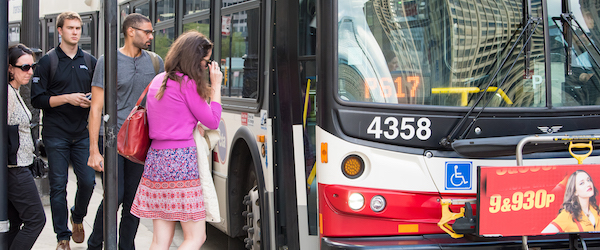PSU Experts in Transportation and Homelessness Collaborate on National Transit Project

Two national research centers at Portland State University have been awarded a new contract from the National Academies of Science (NAS): TCRP J-11/Task 40: Homelessness: A Guide for Public Transportation. We interviewed the two principal investigators to learn more about this new collaboration:
Could you share with us the background and objectives of this new project?
JOHN MACARTHUR, Sustainable Transportation Manager, Transportation Research and Education Center (TREC) at Portland State University
Five years ago the NAS completed TCRP Synthesis 121 report– a synthesis of transit agency practices in interacting with people who are experiencing homelessness. They want to take another look to find out what has changed. Originally, the work was focused on the operational side of things. We’re expanding that scope to look at, not only how are people who are experiencing homelessness impacting the transit system, but also, how can the transit system help that community.
Transit agencies are looking for best practices– ways to address the issue, both in internal operations but also through partnerships. The project is a combination of a literature review, survey scan, and case study development to elevate some of those lessons learned to a national dialogue.
DR. MARISA ZAPATA, Associate Professor of Land-Use Planning at Portland State University and Director of PSU's Homelessness Research & Action Collaborative (HRAC)
Homelessness is a reflection of dramatic societal failure from multiple systems. And it is both the failure of those systems, but now also the responsibility of those and other systems, to respond and address what homelessness produces. And obviously, the people who are experiencing homelessness are the people who are most impacted by the existence of homelessness. But by continuing to allow homelessness in our society, we also have to recognize that there are additional impacts being felt across other systems - particularly in our public assets around land, transit, public infrastructure.
What we're really trying to do here is to highlight places that have found innovative ways to engage in supporting people experiencing homelessness. And also to identify solutions such as fare-free transit.
Why do you think it is so critical to be looking at transit when discussing barriers and opportunities that people experiencing homelessness face?
MARISA
There are a couple of ways in which transit agencies are both impacted by and implicated in homelessness. They also have opportunities to help resolve it. We have seen increases in unsheltered homelessness, particularly on the West Coast. We've got people who are looking for any kind of shelter: living in subway tunnels, sleeping at bus stops, riding rail lines just to stay warm. So you've got people who are experiencing homelessness, which is a critical issue in itself, and it can also be distressing to other passengers.
Looking at the prevention side, how can we ensure that people who are low-wage earners are able to access transportation to jobs and opportunities? If we can keep people at least making minimum wage, then we can often keep people housed by augmenting that minimum wage salary with housing assistance.
People experiencing homelessness need to be able to access work, health care systems, benefit offices...and the best way to do that is on transit. And so we need to think about how people who are in low-income situations or experiencing homelessness use transit systems to better their lives, but then also understand the impacts of homelessness on our transit systems.
JOHN
I think transit agencies can no longer look at themselves as just providing transit. Their role in the way a community functions is so much bigger than that. Transit is the connection that gets a lot of people to essential services that will improve their lives. Transit agencies need to rethink how they are serving all riders, including people experiencing homelessness, and how they can - more humanely and with attention - make the system more usable for all riders. Both for the people who are homeless, but also for riders who are interacting with people using the system.
What unique strengths do PSU researchers bring to the table that will deepen our understanding of transit and houselessness?
JOHN
At PSU we have two national research centers that focus on both sides of this coin, and it's exciting that this is the first project for us to work on collaboratively on such an important and timely topic.
MARISA
Yes, it's the first project of what, we hope, will become a portfolio of work. We've got John, who has an incredible research history with transit agencies and understanding how they function, and is part of TREC, which is one of our national leaders in transportation research. And you've got me. I lead the Homelessness Research and Action Collaborative – one of the few national research centers that is looking specifically at homelessness as an issue.
There is a history of people who study homelessness avoiding research about unsheltered homelessness. And there's a reason for that. Historically, people will use focusing on sheltered homelessness to avoid talking about the actual solution to homelessness, which is housing and support services to maintain housing. So there is a concern that when you look at other things, you're allowing society to ignore what the real solution is. As a research center, we have been willing to engage in a way that other scholars are hesitant to do so.
One of the things that meant a lot to me in this study was the inclusion of the prevention side. So it's understanding and accepting responsibility for where you, as a system, might not have been working as the best actor in helping to prevent homelessness, while also asking for assistance to figure out how to be a part of the solution.
What aspect of this project are you most excited about? What do you expect to be most challenging?
MARISA
The two things I am most excited about, one is to build the continued partnership and relationship with TREC. And then secondly, I think, to bring a unique perspective and sensitivity to this work. To avoid this idea of, 'Get rid of the people, or do the minimum so they don't bother the other people.' There is also a security component of transportation. This is an opportunity, particularly at this moment in history, to think about policing in relationship to people of color, many of whom are experiencing homelessness in these communities.
Working on issues in homlessness is some of the most challenging public policy work you can do right now. It is our responsibility to give as much context as possible to understand what the findings really mean. It’s easy for someone to pull a stat from a survey and make a headline in the paper or use it for arguments that were not at all intended.
JOHN
That attention is both exciting and challenging. But that demonstrates how important the topic is, and how there are widely varying beliefs on how we approach it. This is really that initial step to doing a longer-range research portfolio on this topic area.
This is also an opportunity to not frame this as a situation where you're pitting riders against other riders who are homeless. A big issue for transit agencies is that if some of their riders are complaining and if it’s negatively impacting how often they ride, it hits the agencies’ bottom line. It’s important for those agencies to publicly address safety concerns, while also dismantling negative perceptions of their other riders. That's a tricky path to walk on both sides, but I think that's one of the things we'll be looking at.
Have you noticed promising approaches in the first six case studies that you hope to revisit?
MARISA
It's really promising to see people bringing in social service organizations to do outreach. That is something we're seeing across a number of public agencies, recognizing that not everyone needs to build out their own social service wing. There are lots of different ways in which people are experiencing homelessness, and reasons why. There is also the stigma around it. If you have a sign up saying "If you are homeless, stop here for help," a lot of people might walk past this. If Instead you're setting up coffee chats, and you've got experienced nonprofits involved and you're asking, are you experiencing stress in your life? That can reach people.
The other thing that people really don't fully understand about homelessness is that some people experiencing homelessness are really ill and they need intensive health care support. Those tend to be the people who get the most attention, in terms of people reacting and being afraid of them. And so those folks need a very specific kind of outreach. Having people who are there to build the relationships and to really establish trust – which is what one of the cases talked about, that trust development – is so essential to being able to help someone move into housing and be willing to trust service providers again. The agencies that are looking for those partnerships, and are able to effectively implement them, are what I'm most excited to follow up on.
JOHN
In addition to these promising approaches – like providing crisis support with trained staff and acknowledging how to deal with this in humane and appropriate ways – I think it will be really interesting coming back to these agencies after five years and saying, this is what was written up about you; how have things changed? What worked, what didn't work? The case studies cover different sized cities and geographic areas, so this really is a national approach. Our ultimate goal is to create a guidebook for agencies who are looking to build these types of programs, as well as understand where the network is. What other agencies can they talk to that are already doing that work? So the outcome is a very practical, practitioner-oriented guide.
ABOUT THE RESEARCHERS
John MacArthur is the Sustainable Transportation Program Manager for TREC and the Principal Investigator for TREC's electric bicycle research initiatives. His research includes low-/no-emission vehicle infrastructure in Portland metro, as well as a climate change impact assessment for surface transportation in the Pacific Northwest and Alaska. He currently manages a complex Federal Transit Administration (FTA) grant to develop and test an emergency transportation recovery plan for the Portland, Oregon Region. Before joining the TREC staff, John was the Context Sensitive and Sustainable Solutions Program Manager for the Oregon Department of Transportation’s OTIA III State Bridge Delivery Program.Marisa Zapata is an associate professor of land-use planning at Portland State University and the director of PSU's Homelessness Research & Action Collaborative. She received her Ph.D. in Regional Planning from the University of Illinois Urbana-Champaign, her M.U.P. in Urban Planning from the University of Illinois Urbana-Champaign, and B.A. in Anthropology from Rice University. As an educator, scholar, and planner, Dr. Zapata is committed to achieving spatially - based social justice by preparing planners to act in the face of the uncertain and inequitable futures we face. She believes how we use land reflects our social and cultural values.The Transportation Research and Education Center (TREC) at Portland State University is home to the National Institute for Transportation and Communities (NITC), the Initiative for Bicycle and Pedestrian Innovation (IBPI), and other transportation programs. TREC produces research and tools for transportation decision makers, develops K-12 curriculum to expand the diversity and capacity of the workforce, and engages students and professionals through education.
The Homelessness Research & Action Collaborative (HRAC) at Portland State University brings together researchers from across the PSU community to work alongside people experiencing homelessness, advocates, service providers, city and county policymakers and other stakeholders to address issues that lead to and perpetuate homelessness.


